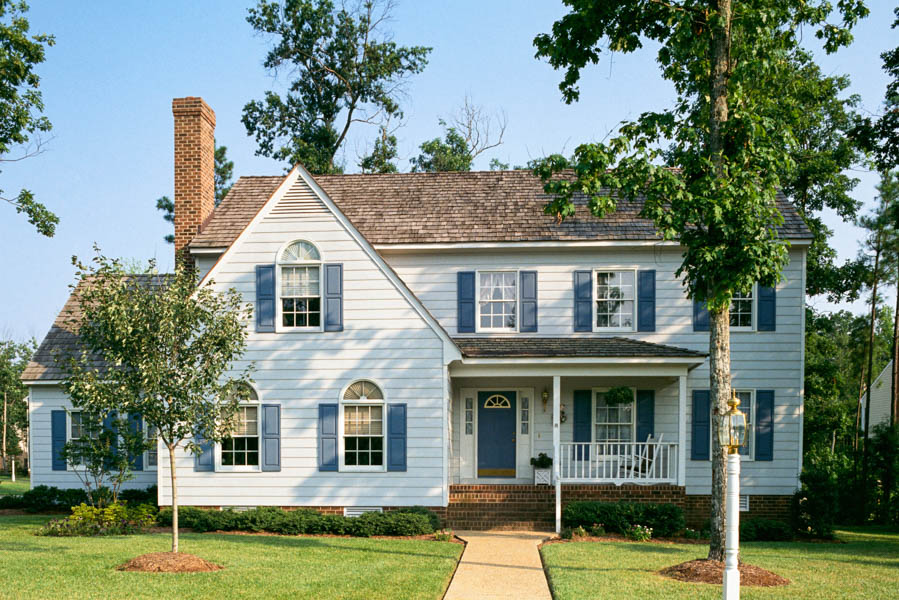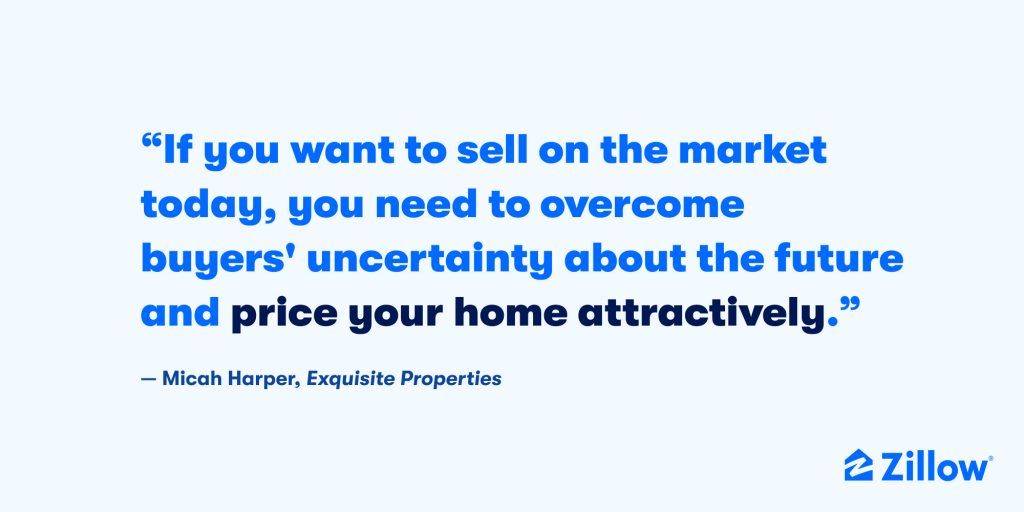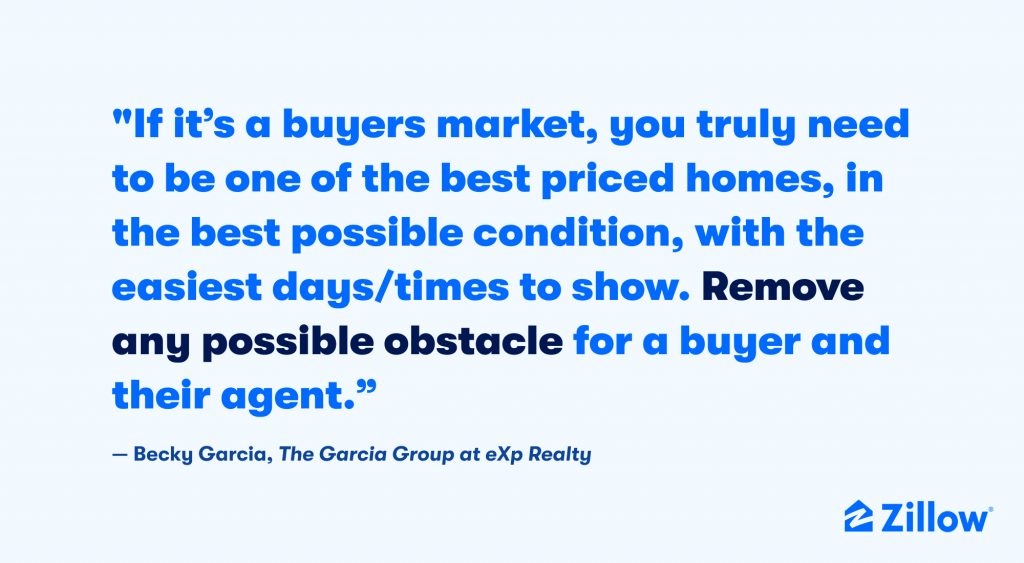Here’s what agents had to say about right-sizing expectations.

The housing market looks a lot different today than it did 12 short months ago. If you’re trying to keep up, you’re not alone. According to a recent Zillow survey of real estate agents, would-be buyers and sellers commonly have misconceptions about the future state of home prices, the probability of a bidding war, how fast their home will sell and more.
Here are some of the most common misconceptions agents hear from their clients, and their advice on the best strategies for a shifting market.
Buyer misconception #1: I should wait until home prices fall to buy a home.

Of the real estate agents surveyed, 46% said the biggest misconception among would-be buyers is believing that home prices will significantly fall. After housing prices skyrocketed, it can be easy to assume that what goes up, must come down. However, current conditions paint a different picture.
Zillow research shows a sharp drop is highly unlikely, but home prices are expected to flatten. The forecast predicts a 0.2% increase by next January.
The present lack of homes for sale is one of the main factors driving the expected leveling of home prices. A low housing supply met with steady buyer demand helps maintain that upward pressure on prices.

And waiting for any substantial change in home prices may mean you’re actually missing out on a favorable buyer environment. “Buyers may think it’s better to wait out the market, but in reality, there is more opportunity in this market than I have seen in the past five years if buyers approach real estate as a long-term investment,” said Michael Perry, an agent who leads The Perry Group in Salt Lake City, Utah.
“If prices or mortgage rates take a meaningful dip, all those sidelined buyers will likely come rushing back to the market, driving up competition and prices,” he said. “If a buyer can purchase today, they have bargaining power, more options and more time to find the right home, instead of being rushed into a purchase they might regret.”
Before touring homes, take time to lock in your must-haves and where you’re willing to compromise so you can find a house that best fits your expectations and budget. You may also want to talk with your real estate agent about putting contingencies in your purchase offer to protect yourself financially and ensure that you’re not locked into a home you can’t afford.
Buyer misconception #2: It’s better to buy a house once mortgage rates drop.

In just two years, 30-year fixed mortgage rates went from historical lows (2.65% in January 2021) to the current reality of more than 6%. That jump can feel like a leap for many buyers right now. However, according to 35% of agents surveyed, it may be a mistake to believe it’s better to wait for the mortgage rates to come down.
Inflation is decelerating, but not as fast as anticipated, and mortgage rates are prolonging a recent record of volatility in 2023. It’s nearly impossible to time the market, and whenever costs come down, competition for homes rises.
“I advise clients to look at the entire financial picture and not just their payment,” said Micah Harper, licensed attorney and broker of Exquisite Properties, based in San Antonio, Texas. “For example, when rates were in the 4% range, buyers had to offer over list price and they could not negotiate any repairs or seller concessions. On a $400k home this could easily amount to $40,000 or more.”
Fast-forward to today and there’s a higher probability a buyer will be able to find a home under list price with seller concessions and repairs, Harper said. “Plus, you can opportunistically refinance your interest rate, but you can’t renegotiate the purchase price.”
So instead of waiting for rates to drop, consider taking steps to determine if and when it’s the right time for you to commit financially to a home based on current circumstances. That means shopping around for lenders to see what home loan amount you can qualify for and whether you can comfortably afford the costs of homeownership, such as regular maintenance and paying for unexpected repairs. To help buyers figure out their housing budget, 44% of real estate agents surveyed said the most important step is to get their financing in order.
Seller misconception #1: My home will get multiple offers and sell quickly.

Sellers may feel that they’ll move their homes quickly because there was a relatively recent surge in demand. In fact, 81% of agents surveyed said those interested in listing their homes commonly believe they’ll get multiple offers on their homes.
But putting up a “for sale” sign doesn’t necessarily mean offers will pour in overnight and incite a bidding war. Sellers are more likely to need to prepare their homes for more discerning buyers, as 56% of agents say that home buyers are taking more time to think about a home. And 55% of buyers also offer below the listed price.

“[Sellers] have to roll up their sleeves and make necessary repairs and home improvements before listing their home for sale,” said Koby Sway, an agent with The Briley Team in Omaha, Nebraska. “It’s more important than ever to get the pricing right when competing against other sellers for a smaller pool of buyers.”
That’s not to say sellers won’t be able to sell their homes for a reasonable price. It’s more that they probably should not expect their homes to go under contract within days of being listed.
The median time on market of 31 days in January indicates that buyer competition for attractive listings is livelier than pre-pandemic norms (more than 40 days to pending), but not as furious as in 2022 (nine days to pending) or 2021 (17 days to pending).
Seller misconception #2: I won’t need to cut my listing price.

It’s a widespread belief among sellers that they won’t need to lower their listing price when selling a home right now — 74% of agents surveyed said that’s a common mentality. Yet the share of listings with a price cut in January was 22% — that’s about one out of five sellers. This is the highest January rate through at least 2018, when Zillow began collecting this data.
Pricing is one of the most important tactics in selling a home right now. It’s “everything,” said Becky Garcia, team lead of The Garcia Group at eXp Realty in Phoenix, Arizona. “To get pricing wrong means they are getting no showings, no offers and overall no interest. If it’s a buyers market, you truly need to be one of the best priced homes, in the best possible condition, with the easiest days and times to show. Remove any possible obstacle for a buyer and their agent.”

Consider this: Homes that aren’t competitively priced tend to stay on the market longer, at a median of 54 days. Competitively priced homes that are going under contract in 19 days, compared to 29 days nationwide before 2020.
“If you want to sell on the market today, you need to overcome buyers’ uncertainty about the future and price your home attractively,” Harper said, adding that he looks at comps from the last six months instead of the last 12 with his clients to present a more accurate picture. “And we focus a lot on the other competitive homes currently for sale to make sure we are the most compelling option in terms of price and amenities.”

